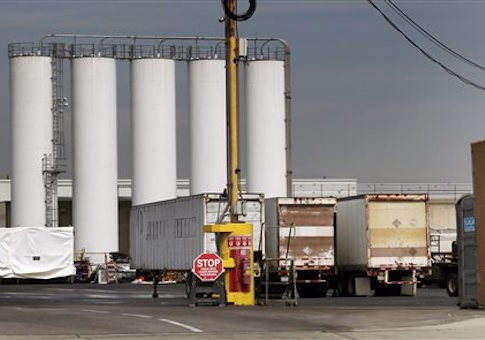The Environmental Protection Agency (EPA) does not effectively track hazardous waste coming into the United States, posing "unknown human and environmental exposure to toxic substances."
According to an audit by the Office of Inspector General (OIG) released Monday, the United States receives roughly 90,000 tons of hazardous waste a year from foreign countries, primary from Canada and Mexico. The EPA is responsible for managing hazardous waste from "cradle to grave" via the Resource Conservation and Recovery Act (RCRA).
The audit found the agency’s data collection on imports has "major discrepancies in hazardous waste import volumes, indicating that the EPA has incomplete knowledge of hazardous waste import shipments."
Hazardous waste imports include liquids, solids, gases, sludges, and "solvents, acids, heavy metals, such as cadmium and mercury, and used batteries containing lead."
"Based on our assessment of data in EPA information systems, the EPA has an incomplete picture of hazardous waste entering the country," the OIG said. "This can give rise to undetected and unenforced violations of federal hazardous waste laws, which could result in unknown human and environmental exposure to toxic substances."
"The EPA may be unaware of shipments that do not reach their intended destination facilities, as well as significant discrepancies in the volume or nature of hazardous waste shipped," the OIG added.
The audit revealed that the EPA is not meeting federal regulations requiring the agency to keep track of the waste it approves to enter the country. The EPA is missing consent forms—mandated under RCRA to give the government’s approval to accept hazardous waste from foreign countries—for over half of toxic waste manifests.
Hazardous waste shipments to the United States must have a manifest, which identifies where the waste came from, the type, volume, dates of shipment, and when it will reach its final destination. Hazardous waste can be transported to treatment, storage, and disposal facilities in the United States.
In addition, "the EPA letter consenting to imports did not consistently include sufficient information to verify that the types of hazardous waste shipped were those which received consent," the OIG said.
Manifests of hazardous waste also did not match data from the Biennial Report (BR), the EPA data system that documents "the nature, quantities and disposition" of hazardous waste received by treatment facilities every two years.
"The EPA does not have an accurate accounting of hazardous waste coming into the
United States," the OIG said. "Comparison of import quantities for 2009 showed [the Office of Federal Activities] OFA received manifests for less than half the waste identified in the BR."
"OIG analysis of 2011 data also showed much of the waste documented in the manifests received by OFA was not reported in the BR," they said.
The audit also found a discrepancy in the law that has left the EPA and Customs and Border Protection (CBP) unclear on which agency is responsible for stopping unauthorized hazardous waste imports at U.S. borders.
"Lack of explicit authority restricts the EPA’s ability to prevent unconsented hazardous waste shipments from entering the United States," the audit said. "This is a gap in the federal law that governs the management and handling of hazardous waste and its intent to address ‘cradle-to-grave’ management of hazardous waste.
"[N]either the EPA nor CBP believes they otherwise have explicit authority to stop unconsented shipments of hazardous waste at the border," the OIG said. "The EPA needs to seek explicit authority to stop unconsented imports at the U.S. border."
The report also notes that the EPA is not using the clear enforcement powers it has over facilities in the United States that violate regulations.
The OIG said the EPA has "failed to take enforcement action against domestic entities when RCRA import regulations are violated," and "does not review manifests or data to identify regulatory violations and pursue appropriate enforcement actions."
The OIG analyzed a sample of over 200 manifests between 2011 and 2012 to complete the audit.
An EPA spokesperson said the agency agrees with the OIG’s recommendations to improve its monitoring of hazardous waste imports.
"EPA remains committed to strong oversight of hazardous waste imports, and to protecting Americans from the potential dangers of exposure to these materials," they said.
"EPA will increase its compliance monitoring activities by reconciling its import data, reminding importers of their reporting obligations, and exploring with the U.S. Customs and Border Protection the possibility of using the International Trade Data System to enhance domestic monitoring," the EPA added. "The agency will also discuss with administration officials outside EPA the possibility of obtaining import control authority to prevent the import of hazardous waste without prior EPA consent."
